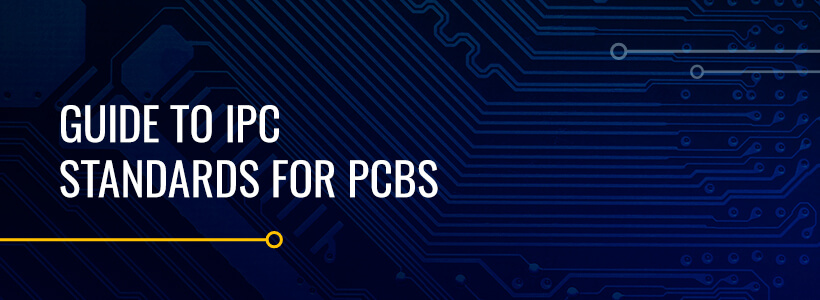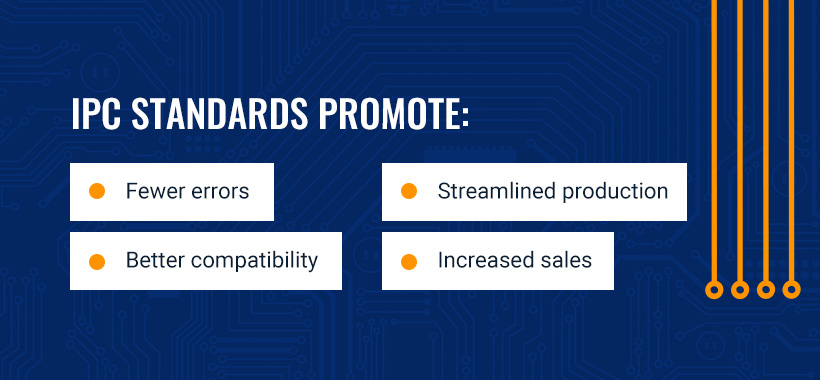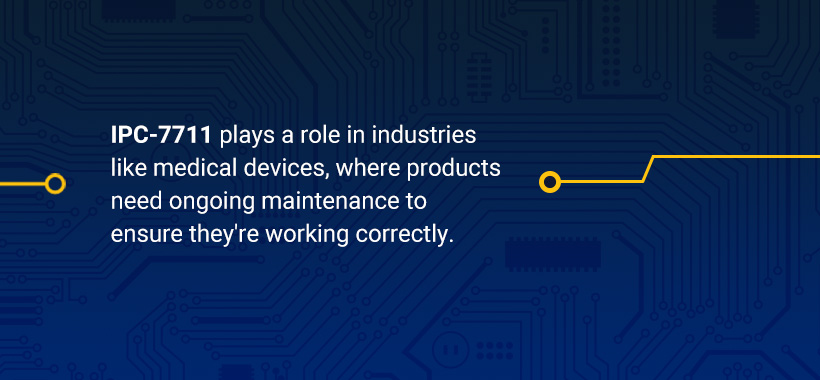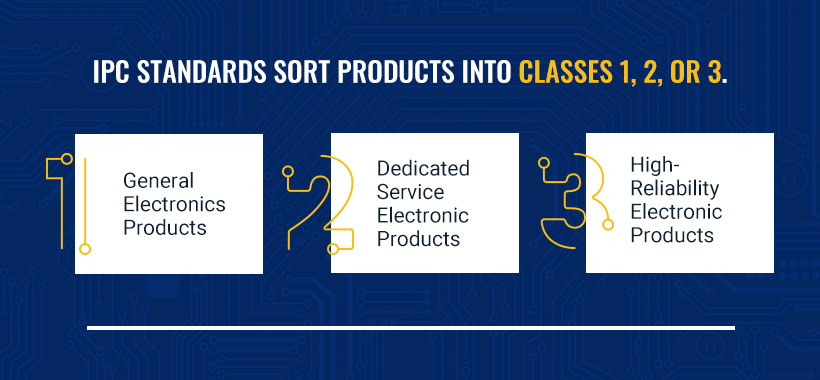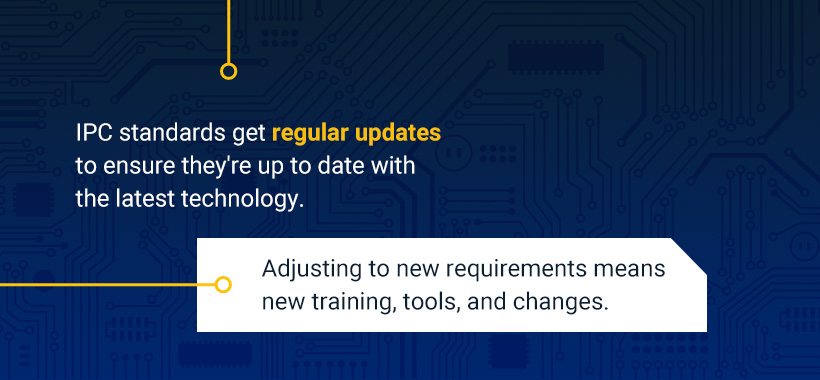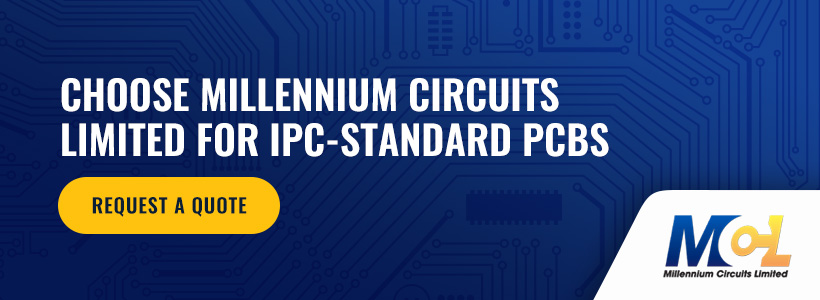Updated on December 31, 2024
Printed circuit boards (PCBs) are the backbone of the electronics world. They support everything from medical devices and industrial equipment to wearable smart pieces. While PCBs are essential electrical components, how can consumers ensure their products perform as expected?
What Are IPC Standards?
The Institute for Printed Circuits (IPC) was developed to support consistency and safety in electronics manufacturing. IPC standards are essential guidelines for engineers, designers, and original equipment manufacturers (OEMs) in electronics production. The IPC definition and printed circuit board standards — along with other standards such as ISO 9001 and AS9100 — protect consumers and manufacturers, creating a better product.
IPC standards extend beyond PCBs. While IPC covers electronics manufacturing in general, it also provides detailed standards for the entire PCB life cycle. IPC has over 300 standards to ensure manufacturers have the support they need to standardize their PCB creation.
IPC standards are created by volunteer committees. This process makes compliance fair for businesses and ensures the electrical community’s opinion is always at the forefront. Additionally, the IPC provides resources and support for organizations looking to boost compliance. PCB and electronics manufacturers should follow IPC standards to reduce defect rates and stay regulation-compliant.
Are IPC Standards Required?
IPC standards are not legally required, but they’re widely accepted as the industry standard for PCB manufacturing. Both using these standards and working with companies that use these standards can help maintain product quality and safety.
Manufacturers can use IPC standards as a jumping-off point for meeting legal requirements. For example, the United States FDA requires medical devices to meet Quality Systems regulations. Following IPC standards can help you align with these requirements more easily. Additionally, the IPC-1752 standard supports European REACH regulations, helping regulate hazardous substances. The IPC’s meaning in electronics extends beyond basics to support streamlined compliance worldwide.
Why Do IPC Standards for PCBs Matter?
PCB standards set by the IPC are crucial in manufacturing. With technology becoming more advanced, PCBs need to meet specific standards to work well in complex devices. IPC standards provide essential guidelines for anyone who wants large-scale, consistent results. These standards promote:
- Fewer errors: OEMs and designers following IPC standards can minimize the risk of errors. Fewer errors mean lower rework or refund costs, reduced failure rates, and lower product recalls. Manufacturers can streamline their processes and use clear guidelines to avoid confusion. Facilities can enjoy reduced manufacturing costs when they boost efficiency and minimize errors.
- Better compatibility: IPC standards boost compatibility worldwide. Manufacturers source components from suppliers worldwide. IPC standards provide a universal guide for quality. With manufacturers, engineers, and suppliers following the same guidelines, products can better meet user expectations.
- Streamlined production: These standards standardize the design and production process, increasing efficiency. Teams can communicate better with clear guidelines to reference. Better efficiency means reduced lead times and faster time to market.
- Increased sales: Using IPC-compliant products can give you a competitive advantage, as they act as a benchmark for global competitiveness. Procurement for government or international contracts is impossible without adherence to the pertinent standards throughout the supply chain.
Whether you’re building your own PCBs or looking for a reputable producer, IPC standards matter. These standards are a baseline indicator for quality in PCB design. Choosing PCBs that comply with IPC standards means you’re getting products that perform as expected according to a global standard.
Key IPC Standards for PCBs
With over 300 PCB standards from IPC alone, it’s easy to get lost. Understanding the most relevant IPC standards is a great way to ensure your products meet industry expectations. Here are some of the most important IPC circuit board standards:
IPC-A-600: Acceptability of Printed Boards
This standard provides criteria for the visual quality and acceptability of PCBs. Readers can use this standard to create uniform guidelines around PCB quality. Inspectors and manufacturers should reference this standard to confirm only high-quality boards make it through. Evaluation criteria include:
- Pits
- Scratches
- Inclusions
- Other internal defects
IPC-6012: Qualification and Performance Specification for Rigid PCBs
IPC-6012 focuses on PCB performance and durability. It covers requirements for the electrical, thermal, and mechanical properties of PCBs. Boards that meet these standards can reliably handle expected wear and stress, allowing consumers and manufacturers to enjoy longer-lasting and more durable PCBs.
IPC-A-610: Acceptability of Electronic Assemblies
This standard focuses on the quality of electronic assemblies, including PCBs. Readers can refer to this standard and follow guidelines for assembly cleanliness, soldering, and component placement. It’s critical information for OEMs since it provides guidance for assembling products and checking their function. With this reference guiding production, you can catch common issues like misalignments.
IPC-2221: Generic Standard on Printed Board Design
IPC-2221 establishes best practices for PCB designers. It covers design aspects that affect performance and manufacturing. Following IPC-2221 during the design phase can reduce errors and production challenges. This standard covers:
- Materials
- Layout
- Conductor spacing
Following careful design guides ensures consistency across the board while maximizing PCB efficiency and quality.
IPC-7711/7721: Rework, Modification and Repair
This standard focuses on PCBs that have to go through reworks. While everything can go right during production, PCBs can still experience issues. However, reworking or modifying PCBs without guidelines can affect their quality and durability. These standards let you know how to rework, modify, and repair PCBs. IPC-7711 plays a role in industries like medical devices, where products need ongoing maintenance to ensure they’re working correctly.
What Are the IPC Classes?
IPC standards sort products into Classes 1, 2, or 3. Each class has unique testing, quality, and application expectations. You have to understand your equipment class to ensure you’re following the correct standards.
Class 1: General Electronics Products
Class 1 standards apply to everyday, general-purpose electronics. These electronics need good performance, but they don’t need to be perfect at all times. Think of products like household gadgets, toys, and basic appliances. If your washing machine breaks or becomes less efficient sometimes, it’s certainly an inconvenience — but your life isn’t significantly affected.
Since Class 1 allows minor imperfections, these products have lower testing and inspection requirements. Less strict standards save on manufacturing costs and let producers get their products out faster.
Class 2: Dedicated Service Electronic Products
Class 2 is a step up from Class 1. These electronics should perform reliably in non-extreme conditions. Class 2 products might include communication devices, office equipment, and some automotive components. They need stricter testing to ensure they last a long time. Class 2 electronics can have minor defects as long as they don’t impact product reliability or safety.
Class 3: High-Reliability Electronic Products
Class 3 is for instances when failure is not an option. Think of lifesaving medical devices, aerospace designs, or military products. Electronics in this category must meet the strictest quality standards. They’ll undergo extensive testing, with every defect analyzed to determine if it poses an unacceptable risk. Class 3 devices are built to withstand challenging environments — they must work reliably under the most demanding conditions.
How to Choose the Right Class
Finding the right IPC class for your product comes down to what it will be used for. If your product is designed for high-stress, critical uses, you need to go with Class 3. If it’s okay for there to be some defects without seeing performance problems, follow Class 1 guidelines. Finally, if your product needs solid reliability but won’t see extreme conditions, consider Class 2. Choosing the right class lets manufacturers and consumers find the right balance between costs and performance.
Common IPC Electronics Standards Challenges
Working with IPC standards can be challenging for OEMs and engineers. Balancing strict guidelines with design and production takes some work. Here are some of the roadblocks you might run into:
- Complex standards: IPC standards cover more than just PCBs. Whether you’re looking at IPC soldering standards or other electronic guidelines, it’s easy to get lost. Each standard has its own requirements, and you must understand them thoroughly on top of other industry standards, customer specifications, process capability constraints, emissions regulations, and more.
- Choosing a class: Picking the right class can get confusing, especially if you’re new to the industry. If the class is too low, the product might not perform reliably — but choosing a higher class can drive up production costs unnecessarily. Through risk analysis, you must balance everything to find the best class.
- Limited resources: Products needing Class 2 or 3 standards can strain your resources. These classes demand advanced testing and equipment, which could strain smaller company budgets. Some applications have a 100% inspection requirement, such as aerospace. You could see slower production, significantly impacting the bottom line. It’s challenging to keep pace with your timelines while ensuring thorough testing.
- Constant updates: IPC standards get regular updates to ensure they’re up to date with the latest technology. Updates improve product quality, but they also mean OEMs and engineers need to keep their finger on the pulse. Adjusting to new requirements means new training, tools, and changes. Tight schedules could see production disruptions while adjusting to new standards.
- Ensuring flexibility: IPC standards help consistency and reliability, but they can restrict flexibility. Engineers might find that following standards limits their customization or innovation with products. Discovering ways to be creative while meeting standards can get tricky in the long term.
Following IPC PCB Standards in Design and Manufacturing
Following IPC standards in PCB design and manufacturing aids in creating the high-quality, reliable products consumers need. If you want to boost durability and consistency in your operation, you should work within the right IPC standards.
The design phase is where you should start with your IPC standards. Look to IPC-2221 and other similar standards to find rules on layout and spacing. These small details greatly impact a PCB’s durability and performance. The closer you stick to IPC standards from the start, the lower your risk of production problems. Always work with a trusted PCB vendor. They’ll stick to IPC guidelines in addition to other industry standards and specifications and ensure you get the best quality product for the job.
Here are some tips to help engineers and OEMs integrate IPC requirements while staying productive:
- Communicate: Engineers and OEMs should keep communication lines open with the manufacturing team. Give everyone access to relevant class standards and implement quality checks. These make it easier to keep products consistent and high-quality. Encourage teams to speak up about IPC standards so everyone can learn and grow together, and communicate to understand the customer’s requirements and how they fit in — or sometimes conflict — with existing standards.
- Be consistent: Everyone involved in PCB production should be on the same page. Set clear expectations and reduce revisions when everyone works according to the same standards. The design and production team should clearly understand the class and level of quality required so they can work toward the same goal, improving consistency.
Why Trust Us?
Millennium Circuits Limited (MCL) is a trusted provider of high-quality PCBs. With over 15 years of experience, you can rely on us to craft PCBs that are exactly to your specifications. MCL’s commitment to quality is backed by our ISO 9001: 2015 certified status. We ensure our products follow a strict framework for quality management and control processes.
Each PCB produced by MCL is crafted to meet precise customer specifications. With our support, clients can enjoy adaptability in even the most complex projects. Our comprehensive quality assurance protocols, like electrical circuit tests, include thorough testing and inspection. These practices ensure every PCB meets industry standards and your unique requirements.
Additionally, MCL emphasizes technical excellence through our design-for-manufacturability approach. We let clients optimize their PCB designs for enhanced efficiency and cost-effectiveness. Our technical consulting services further support you through the complex PCB design process. Whether you need design changes or we find cost-saving areas, we’ll help optimize your PCBs.


